“The Ultimate Computer”
Written by Laurence N. Wolfe and D.C. Fontana
Directed by John Meredyth Lucas
Season 2, Episode 24
Production episode 60353
Original air date: March 8, 1968
Stardate: 4729.4
Captain’s log. The Enterprise has been summoned to Starbase 6 for an experiment. Dr. Richard Daystrom—who designed the duotronic computer systems used on the Enterprise—has developed the M-5 multitronic computer system. The M-5 will be installed on the Enterprise and tested. It will require only a crew of twenty—Kirk himself just has to sit back and let the machine do all the work.
Part of the experiment involves war games—the M-5 controlled Enterprise versus a fleet of ships led by Commodore Bob Wesley and the Lexington. It’s Wesley who gives Kirk his orders.
Daystrom hooks the M-5 up in engineering. On Kirk’s order, Scotty hooks the computer into the ship’s main power. There’s a hiccup, but Daystrom fixes it, refusing Spock’s assistance. Kirk is apprehensive—McCoy points out that it’s natural to be fine with mechanization taking away jobs until it’s your job, but he also points out that if Kirk has to ask if he’s afraid, he probably isn’t.
The Enterprise performs some simple maneuvers, then approach a planet. M-5 puts the ship into orbit and makes recommendations as to who should go on the landing party–Kirk insists on the latter himself. The captain recommends a survey party that avoids the natives and includes Kirk, Spock, McCoy, an astrobiologist, and a geologist. M-5 has its own recommendations: Spock, the astrobiologist, and a different, lower-ranking, geologist due to his experience on a merchant vessel in the sector. M-5 also deems Kirk and McCoy to be nonessential personnel.
M-5 shuts down power on several decks. Daystrom says it has done so because those sections are unoccupied. Spock also notices that the M-5 is drawing more power from those shut-down decks.
Uhura reports two contacts: it’s the Excalibur and the Lexington, here for an unscheduled battle drill. M-5 responds to Wesley’s hail before Uhura can and also goes to red alert before Kirk can sound it. M-5 runs the whole battle itself, leaving Sulu and Chekov to just narrate it as the Enterprise does very well—its response times were far faster than any human could have reacted.
Wesley sends his congratulations to the M-5 unit and his regards to “Captain Dunsel.” Kirk just walks off the bridge, leaving a confused McCoy to ask who the hell Captain Dunsel is. Spock has to explain that “dunsel” is a term used by students at Starfleet Academy to refer to a part that serves no useful purpose.
McCoy brings Kirk a drink to his quarters, and the captain waxes poetic about sailing ships and feeling useless and other fun stuff. He’s interrupted by contact with another ship—it’s not a drill, it’s the Woden, an automated ore freighter.
The deflectors come on and the M-5 brings the Enterprise toward the Woden. Kirk disengages M-5—but it doesn’t take. Sulu can’t fly the ship, Scotty can’t engage manual override. M-5 heads to the Woden, locks photon torpedoes, and destroys it.
McCoy is livid at the wanton destruction, and Daystrom is confused. Kirk wants M-5 disengaged immediately and the tests finished before M-5 actually kills someone. Since they can’t turn the computer off from the console on the bridge, they go to engineering to turn it off at the source. However, M-5 has put a force field around itself so they can’t approach the unit, and when Ensign Harper tries to disengage it from the engines, M-5 fires a laser that vaporizes Harper and also allows it to draw power directly from the warp engine.
Daystrom insists to McCoy that M-5 is growing and learning. McCoy points out that it’s learning to kill, but Daystrom insists it’s just defending itself. (How it needed defending from a robot ore freighter and an ensign is left unclear.) He also insists that M-5 can keep people from dying needlessly in space, which will be small comfort to Harper’s family.
McCoy digs into Daystrom’s psychological history. He won the Nobel and Zee-Magnes Prizes at the age of twenty-four for the development of duotronics. McCoy hypothesizes that Daystrom peaked early and is trying desperately to recapture past glory. The M-1 through M-4 were all unsuccessful (presumably they all fell into the swamp…), and McCoy wonders if the M-5 is just as unsuccessful.
Spock and Scotty try to bypass the primary circuits to helm and navigation, but M-5 rerouted as soon as they started, and so it fails. M-5 still controls the ship.
Daystrom finally explains his “new approach” to computer science with multitronics: he’s imprinted human engrams upon the M-5, allowing it to think like a person.
Uhura reports that the Lexington, Excalibur, Hood, and Potemkin are approaching for the war game. M-5 charges phasers at full power and fires on the Lexington. The war games deteriorate pretty quickly, with hundreds of dead. Wesley contacts Starfleet Command asking permission to destroy the Enterprise.
Daystrom reveals that M-5 was imprinted with his own engrams. Spock hypothesizes that perhaps Daystrom can talk to it. Daystrom agrees, and he tells M-5 that it’s committing murder. It was created to save people, not murder them. Unfortunately, Daystrom has gone completely binky-bonkers, cluck-cluck, gibber gibber, my old man’s a mushroom, etc., embittered and miserable because he’s invented nothing new since his twenties. Spock neck pinches him before he can complete his epic tirade about how nothing will stop him or M-5.
Uhura reports that Wesley has been authorized to use lethal force on the Enterprise. Kirk tries talking to M-5 (hey, he’s done it before…). M-5 says it must survive to protect humanity—basically the same speech that Daystrom gave earlier about preserving lives. Kirk points out that it’s committed murder. M-5 says it can’t have committed murder, so Kirk tells it to scan the Excalibur, which has been crippled, all hands lost. Realizing it has committed murder, M-5 shuts completely down, lowering shields. Spock figures it’s guilty and is committing suicide by leaving itself open to attack by the other three ships.
Scotty and Spock unplug M-5 from the ship, but Scotty can’t get communications back online for a bit, so Kirk orders all power shut down, gambling that Wesley wouldn’t fire on a defenseless ship. Sure enough, the commodore breaks off the attack.
McCoy says that Daystrom will have to be committed to rehab.
Can’t we just reverse the polarity? Daystrom has found a way to make computers think like humans: imprinting a human’s memory engrams onto the computer’s operating system. While the phrase “artificial intelligence” isn’t used—the term had only been in use for a decade when this episode was produced—that’s basically what it is. Unfortunately, using the engrams of a guy on the verge of a psychotic break probably wasn’t the best plan.
Fascinating. Spock has an A-7 computer rating, which presumably makes him an ace.
I’m a doctor not an escalator. McCoy is skeptical about the M-5 from jump, and his rant at Daystrom after the Woden is destroyed is epic. “It just destroyed an ore freighter! In fact, it went out of its way to destroy an ore freighter!” But he’s also the one who diagnoses Daystrom’s psychological issues.
Ahead warp one, aye. Sulu is left to spectate as the M-5 does his job.
It’s a Russian invention. Chekov is likewise left to spectate. He and Sulu get a moment of joy when they think they have control back, which is the only real moment the two of them have. Otherwise, they’re just reading off a litany of what M-5 is doing.
I cannot change the laws of physics! Scotty is not happy about the M-5 being hooked up to the engines—he refuses to do so until he gets a specific order from Kirk to do so.
Hailing frequencies open. Uhura’s the only person who can still do things when M-5 takes over, as she can still pick up and route communications.
Go put on a red shirt. Poor Ensign Harper has the bad luck of trying to disconnect M-5 right when it decides to increase power with a big-ass laser. His death changes the tenor of the episode, as M-5 was a nuisance up to that point—once it commits murder, all bets are off.
Channel open. “It would be most interesting to impress your memory engrams on a computer, Doctor. The resulting torrential flood of illogic would be most entertaining.”
Spock, taking the piss out of McCoy.
Welcome aboard. Barry Russo, having previously played Giotto in “The Devil in the Dark,” plays Wesley. Sean Morgan, having previously played O’Neil in “The Return of the Archons” (and who will play that role again in “The Tholian Web”), plays Harper. James Doohan does triple duty, not only as Scotty, but also as the voices of both M-5 and of one of the other commodores, and he’s joined by other recurring regulars George Takei, Nichelle Nichols, and Walter Koenig.
But the big guest is Blacula himself, the great William Marshall, who lends his amazing voice and powerful presence to the role of Daystrom.
Trivial matters: Having written two episodes, show-runner John Meredyth Lucas takes a hand at directing this time ’round, making him the first person in Trek history to both write and direct an episode.
Kirk quotes the famous line from John Masefield’s Sea Fever, “And all I ask is a tall ship and a star to steer her by.” Kirk will quote it again in Star Trek V: The Final Frontier, Quark will paraphrase it in DS9‘s “Little Green Men,” and that quote will be on the dedication plaque for the Defiant in the latter show.
Wesley will appear again in the animated episode “One of Our Planets is Missing,” voiced by James Doohan, and the character also appears in multiple works of tie-in fiction, among them the novels Burning Dreams by Margaret Wander Bonanno, Yesterday’s Son by A.C. Crispin, Allegiance in Exile by David R. George III, Section 31: Cloak by S.D. Perry, and The Disinherited by Peter David, Michael Jan Friedman, & Robert Greenberger (a novel that also features the character of Giotto, also played by Barry Russo, with Wesley making a comment that he likes the cut of Giotto’s jib), and the novellas Where Time Stands Still (part of the Starfleet Corps of Engineers series) and The First Peer (in Seven Deadly Sins) both by Dayton Ward & Kevin Dilmore.
Daystrom will be seen again in the novel The Rift by Peter David. The TNG episode “The Measure of a Man” will establish the Daystrom Institute, a Federation scientific facility named after the character, which will be mentioned in numerous episodes of TNG, DS9, and Voyager.
The Lexington will be mentioned again in DS9‘s “Trials and Tribble-ations.” The Potemkin will be mentioned again in “Turnabout Intruder,” the animated episode “The Pirates of Orion,” and Star Trek VI: The Undiscovered Country.
The remastering of this episode had a nice nod to the tie-in novels. In 2005, Simon & Schuster debuted a novels-only series that took place concurrently with the original series entitled Vanguard. It took place on Starbase 47, a Watchtower-class starbase that was designed especially for the novels series by Masao Okazaki. In the remastered version of this episode, Starbase 6 (which was a reuse of the Deep Station K-7 model from “The Trouble with Tribbles” in the original broadcast) was replaced by a computer-generated Watchtower-class starbase. Reports that Vanguard co-creator/editor (and current Tor Books editor) Marco Palmieri squealed like a small child when the remastered episode aired are unconfirmed. (Oh, who am I kidding? They’re totally confirmed…)
To boldly go. “You can’t simply say, ‘Today I will be brilliant!'” My formative years experiencing Star Trek were twofold. The first was obvious: the reruns on WPIX Channel 11 here in New York City, which was my initial exposure to the show. But the other, and ultimately at least as important, were the adaptations by James Blish (assisted in the end by his widow J.A. Lawrence).
For whatever reason—the vicissitudes of scheduling, both my own and that of WPIX—I didn’t see “The Ultimate Computer” for a long time on television, to the point that I had very little memory of the episode. All I had was Blish’s adaptation in Star Trek 9.
So when I read the adaptation (which I did a lot with the Blish books—those spines are seriously cracked…), my brain filled in Daystrom as a white guy.
And then I finally did catch the episode when I was, I dunno, eleven or twelve or so, and was gobsmacked by the casting of William Marshall—and not just because I was a fan of Blacula.
That was a major formative experience for me, as I realized that I was letting my prejudices shine through. I’ve always made a conscious effort to not default to the white guy every time, and one of the reasons why is because I was wrong about Daystrom for so long.
But that’s only one of the reasons why the casting of Marshall was brilliant. He is simply overpowering: his echo-y voice, his immense height, his commanding presence, all combine to create a character you’re forced to pay attention to. More impressively is that, despite all the opportunities to do so, he doesn’t overplay it. He comes close a few times (like the exaggerated “urk!” expression he puts on when Spock neck pinches him), but he especially plays up the bitterness of the expectations that have been unfairly placed on him.
The moral here is a very simplistic one: machines can’t replace people. Well, that and be careful not to peak in your twenties. The 1960s was when people were genuinely starting to fear that automation would replace people’s jobs, and that’s still a concern five decades later. (As just one example, there are a lot fewer people whose job it is to take your toll in a toll booth than there were twenty years ago.) Star Trek will go down this well again, when we get true AIs in Data and the EMH, but this first look at it is an interesting one. The real compelling story here, though, isn’t really M-5, but Daystrom. This is someone who revolutionized the computing world twenty years earlier and has spent the two decades since living in the shadow of his younger self. Marshall beautifully plays the desperation, the eagerness to prove that he hasn’t blown his wad, that he still can be useful.
Warp factor rating: 8
Next week: “The Omega Glory”
Keith R.A. DeCandido loves rock and roll, so put another dime in the jukebox, baby.











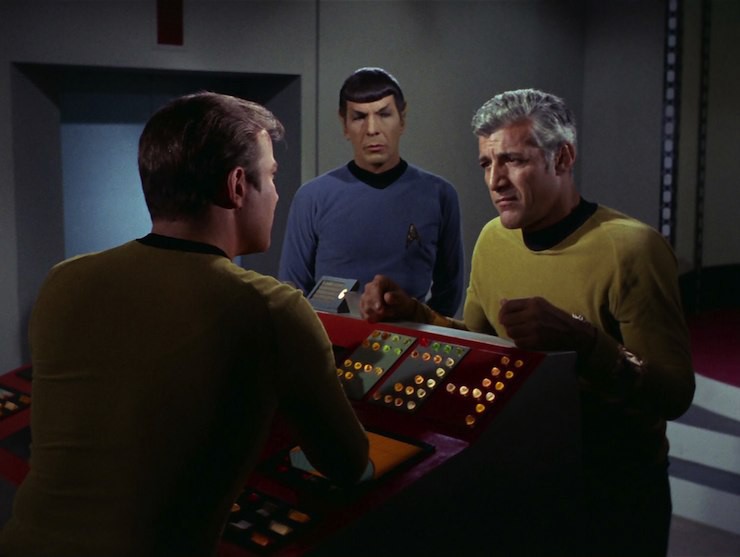
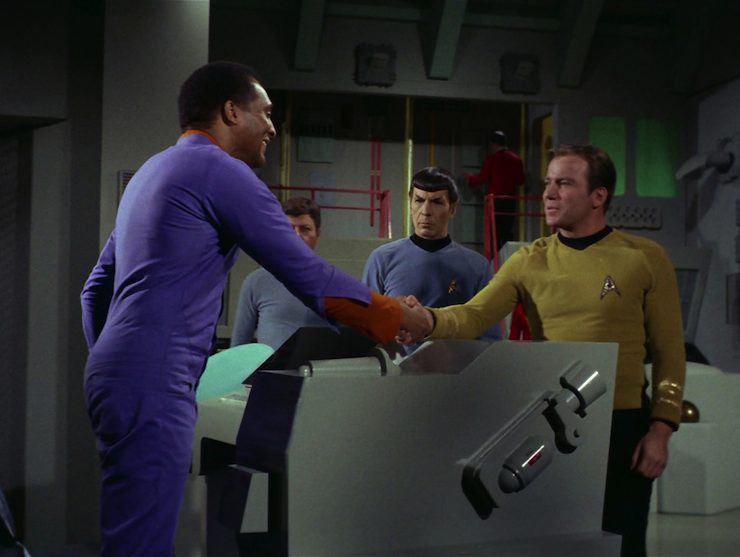
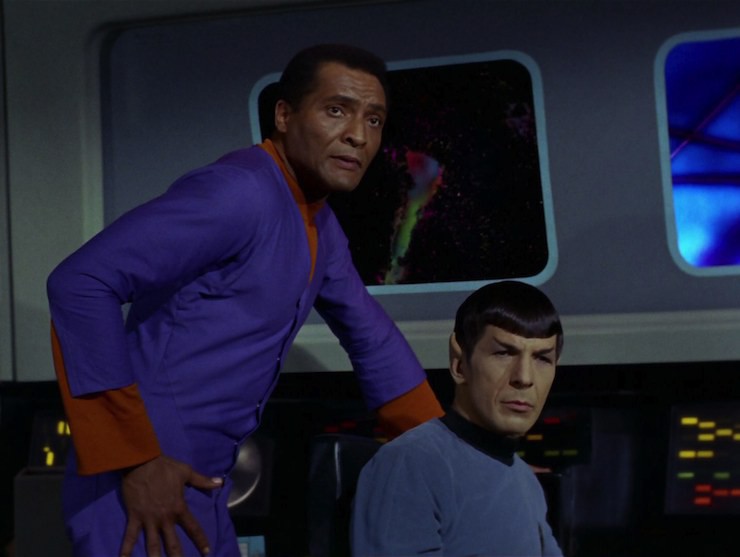
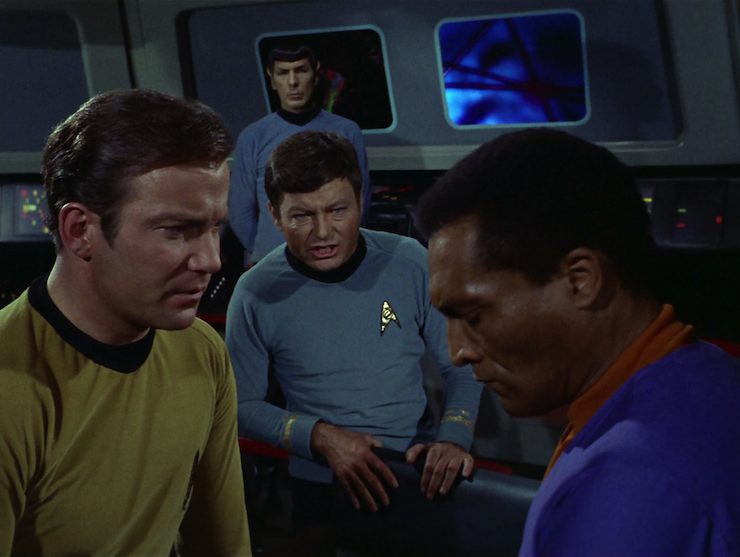

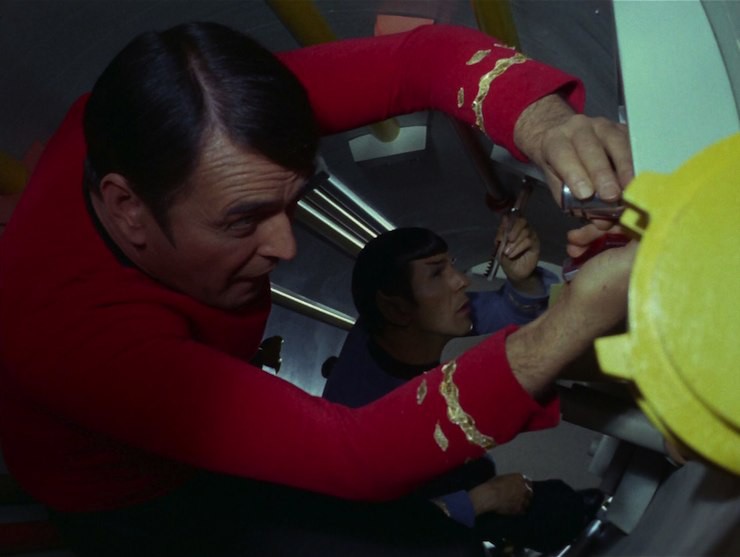

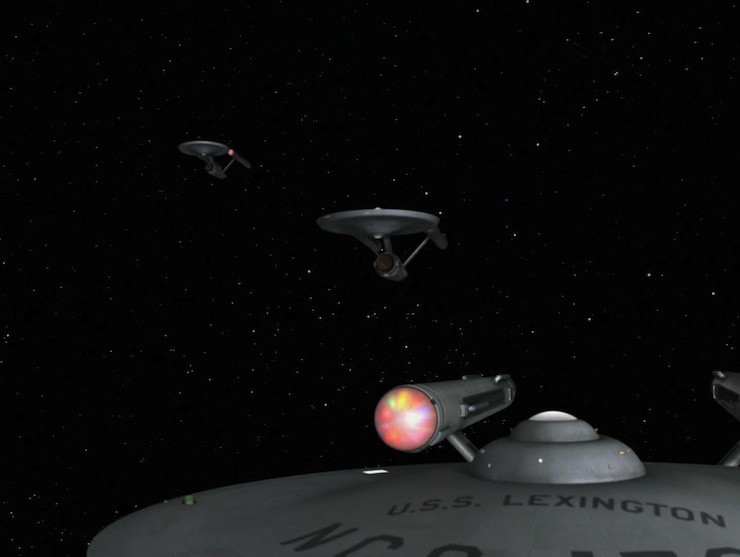
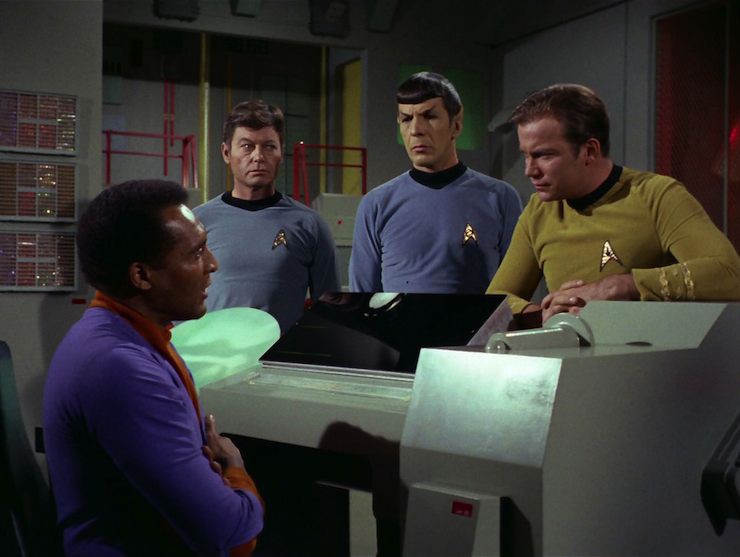
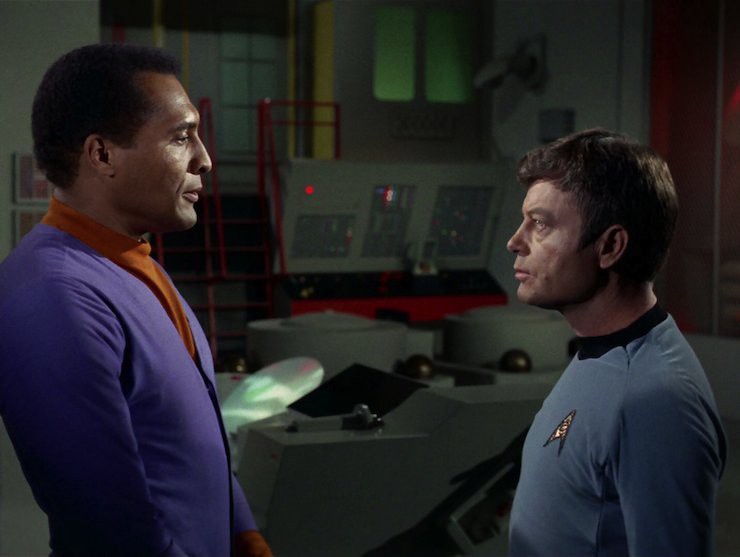
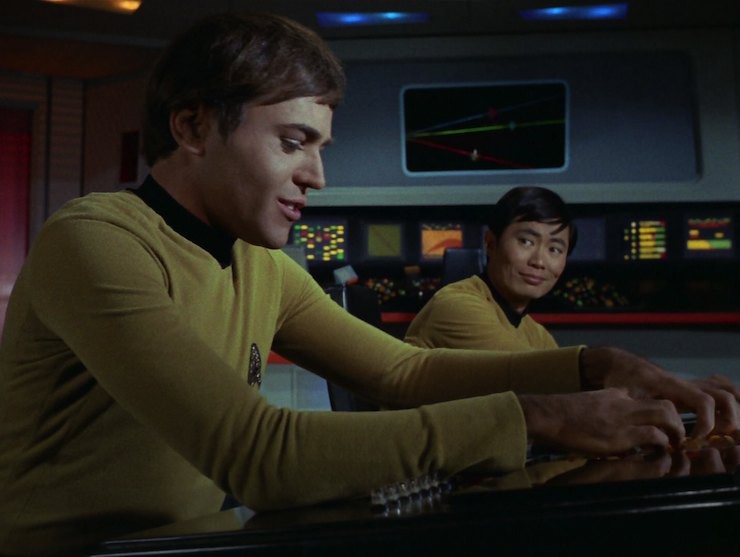
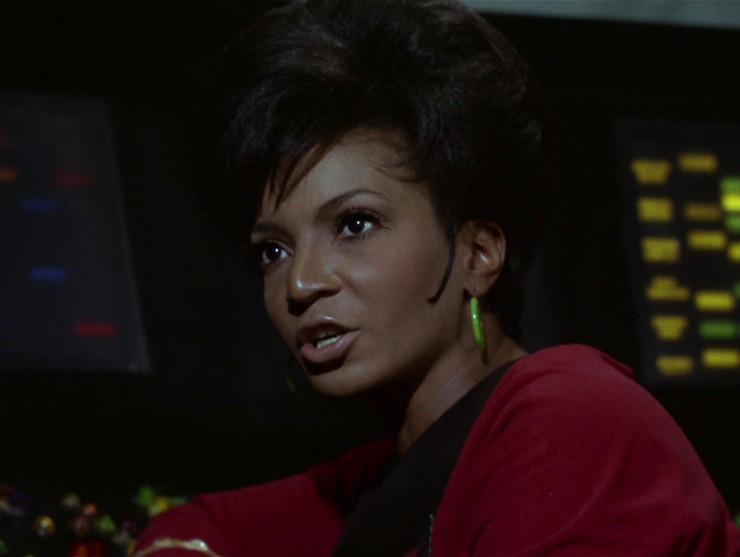
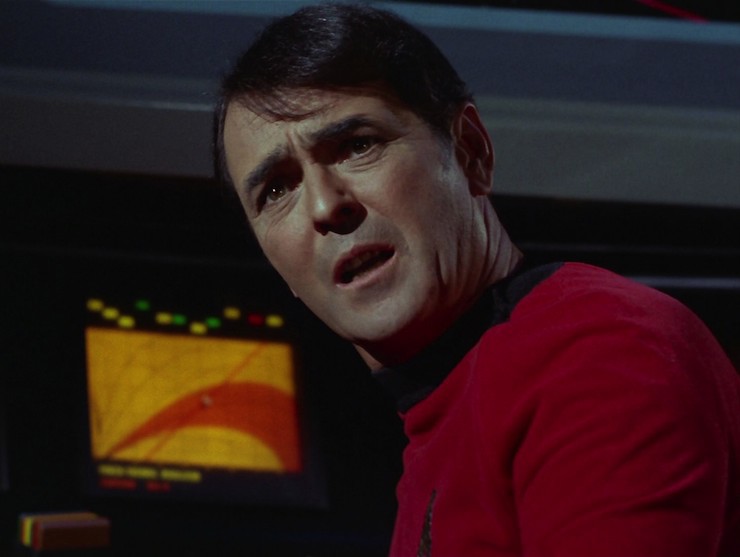
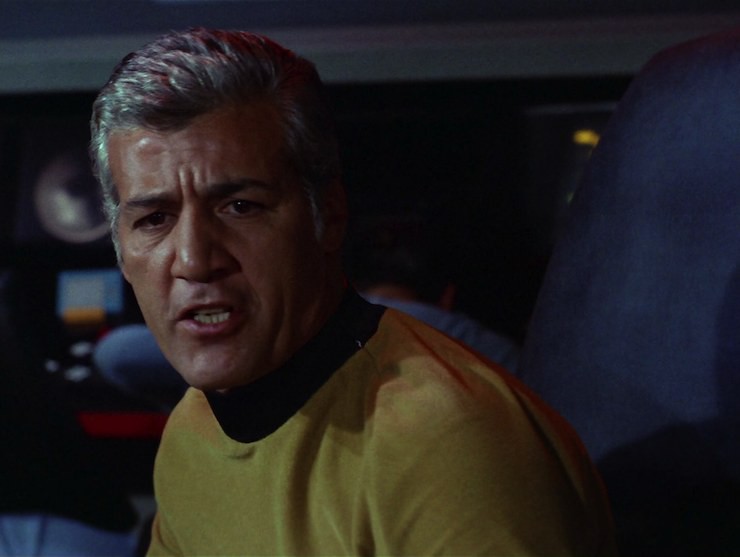


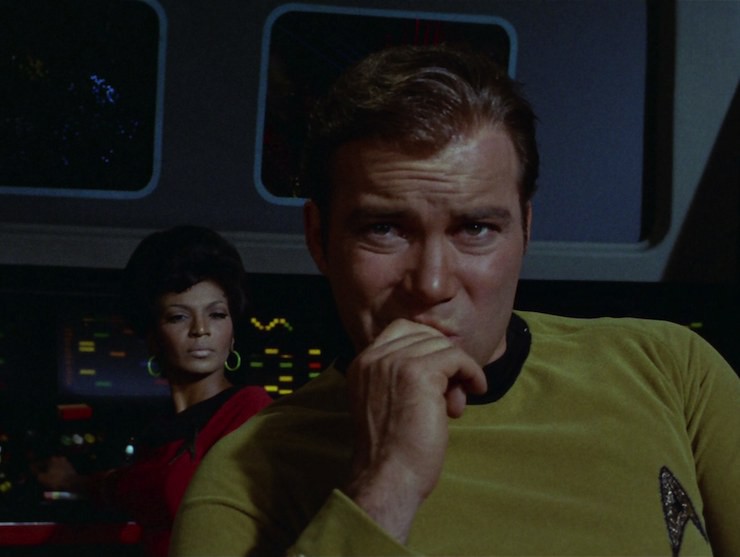
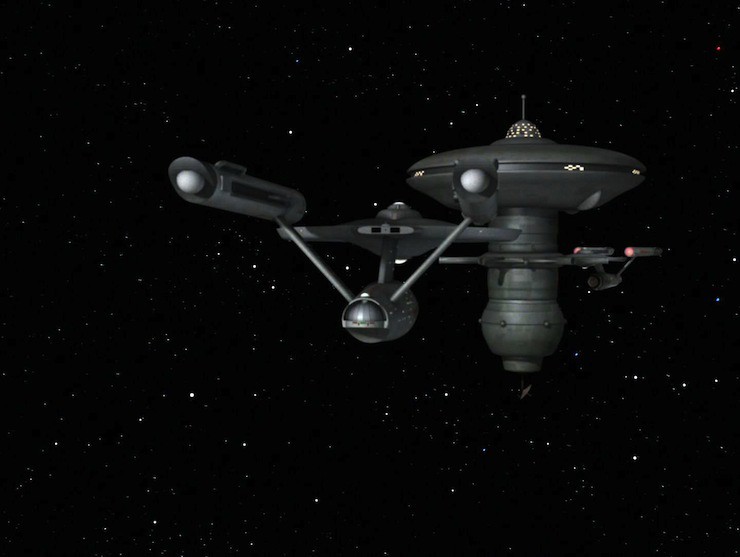
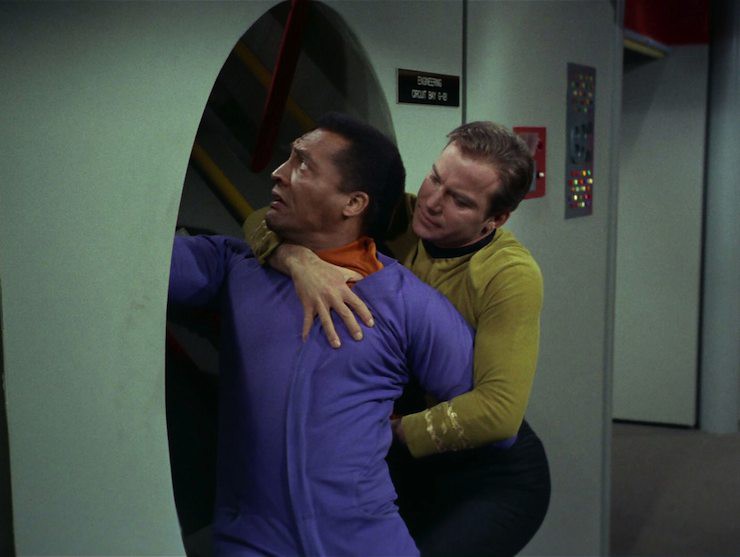
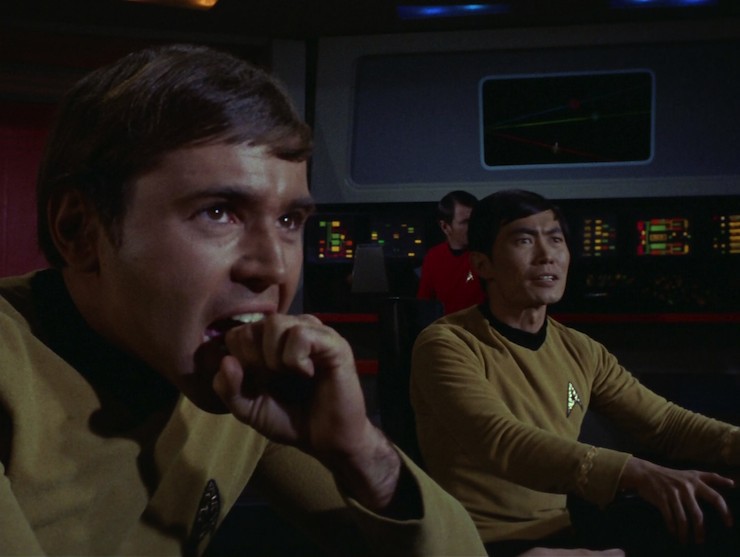
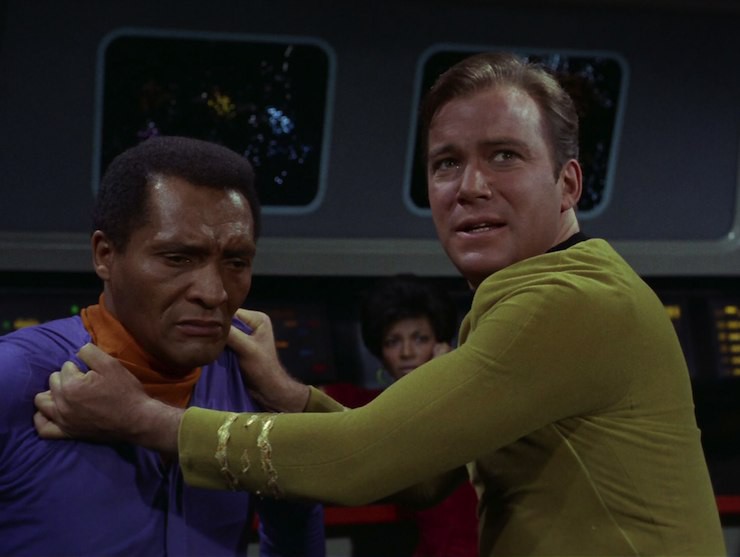
Hmm… Seems like another “Kirk talks the malfunctioning computer/AI into shutting down” story, following in the well-trodden path of episodes like “Return of the Archons” or “The Changeling.” This in no way diminishes William Marshall’s excellent performance as Professor Daystrom or the warning about peaking in your 20s :P
I think Commodore Wesley is probably the sanest, least evil guest starship captain we ever saw in TOS. He’s in a somewhat antagonistic role, but in a way that doesn’t serve him badly as a character. It’s also a reminder of something else. We tend to think of Kirk as being the one legendary captain of the 23rd century, the one name that everyone in the 24th century seems to know and revere, but in TOS, he was the youngest captain of a capital ship, the least experienced member of his breed and probably the least prestigious. The other commanders we met were usually his elders or his superior officers, and in at least one case (Garth), his own idol.
And yeah, William Marshall’s performance really makes this episode shine. This is a classic example of the 1960s pattern of building TV episodes around their guest stars. For all that Kirk’s anxiety over being rendered obsolete is a driving thread, this is really Daystrom’s story and is designed to give Marshall the big bravura performance. It’s also very powerful to see a 1968 television episode portray the most brilliant mind of his generation as a black man, given how many people at the time (and, sadly, today) stereotyped black people as unintelligent, lazy, and genetically predisposed to failure.
You know, for all that the episode makes speeches about how computers aren’t as good at leadership as people, it doesn’t really prove its point, because the reason M-5 goes wrong is because it has the personality of an unstable human. So essentially M-5 screws up because of human fallibility, not computer limitations. So the episode tries for the message of “computers can’t replace people,” but it ends up with the message of “people can’t replace computers.”
And what Daystrom did is like the type of artificial intelligence called whole brain emulation — creating a model that replicates the human brain’s functioning, rather than building intelligence from first principles (known as de novo AI).
Engrams are a real concept in neuropsychology, but the application here is a bit off, since the term specifically refers to the patterns in which memories are theoretically stored, not to the basis of personality or cognitive processes. So a computer with Daystrom’s engrams wouldn’t necessarily think or emote like Daystrom, it would just have his memories.
“(presumably they all fell into the swamp…)” — No, M-1 through M-3 all blew up, and M-4 disappeared in a time warp. (Does anyone still recognize Babylon 5 in-jokes?)
For those who might not have heard it, here is the excellent musical setting of ‘Sea Fever’ written by John Ireland…
https://www.youtube.com/watch?v=b4NUJRpxQbY
@1 Of course, since the big deal about the M5 is that it is a learning machine based on human engrams (apparently with imprinted personality as well), this is maybe the only time talking the computer into shutting itself down makes sense.
“You can’t simply say, ‘Today I will be brilliant!’”
You most certainly can. I do it every day.
“Duns’l” (Dun Sail) not “Dunsel”
A sail that was weathered and faded from the more umber/ochre color of some old sails that were treated with a preservative compound (tanbarked) that made them a rich reddish coffee color.
Unneeded in the days of Powered ships.
I took it to mean “redundant and ready to be retired”
Starfleet doesn’t come off well here– shouldn’t somebody before Kirk have been asking more questions about just how the M-5 worked?
The skepticism around automation, notwithstanding that this particular implementation was bad, strikes me as more of “people are skeptical of automating new things but just fine with things that have ‘always’ been automated” than any coherent argument, much like the panic now over automating some service level jobs but the near-universal acceptance of “booking your own travel” instead of using a travel agent. Couple in the self-interest in losing their own jobs, and you have Kirk/Spock/McCoy at about the least persuasive we ever see them. Note that none of them are the least bit skeptical of an ore freighter being run by remote, presumably because they have no interest in working aboard an ore freighter.
Checking the box to prove that I’m not a robot seems oddly relevant this week. I swear, I’m not, although you can never be sure..
@1/DoubleRedAlert – Hence Keith’s linking to rewatches for those episodes (and “I, Mudd”) in the phrase “done this before.” :)
@6/Jeff – It may originate from Duns’l or Dun Sail (though I can find no references to either online), but “Dunsel” is not incorrect according to Wiktionary.
Don’t be silly, you aren’t really an ace unless your rating is Nitro-9.
The inclusion of a black character as a brilliant computer scientist, with zero commentary on his race (that I recall), is my favorite thing about this episode.
@6/Jeff Gedney: Oh, so there’s actually a nautical origin to the term? I had no idea. And neither did a lot of other people. The Romulan War novels actually feature a Starfleet captain named Roy Dunsel who is rendered ineffectual to make a difference in a key battle, through no fault of his own. Honestly, it felt a little harsh to suggest that history would remember him as useless. I prefer the idea that there’s a more impersonal origin for the term.
As the OED has no entry for “dunsel” (or dunsail or duns’l), I’m forced to conclude that Star Trek invented the term, the “dun sail” explanation is a rationalization, and Wiktionary is bogus (that last part should not be controversial). Pending evidence to the contrary, I say the term was coined by the writer in 1967.
(Edit: on an SF message board, I find someone claiming that a dunsail is a small sail at the prow of the ship that looks good but doesn’t actually provide motive power, and that the term was in use at least in the 1950s, pre-ST. However, that person didn’t cite a checkable source, so I remain skeptical for the moment.)
@6 I don’t think that version of the argument holds water since dun is just a color of weathered canvas. There is nautical poetry that talks about seeing a “dun sail against a clear sky”, things like that, where the sail is clearly functional.
@10/StrongDreams – I will totally grant that Wiktionary is not a reliable source. It was, however, more neutral than Urban Dictionary or Memory Alpha, which also listed “dunsel” as the spelling. :)
In all the times I’ve viewed this episode, I’ve never noticed those two moments of foreshadowing that something might not be right with M5 (problems installing and drawing extra power). Nice catch.
Jeff: the spelling in the script and in James Blish’s adaptation were both “Dunsel.” While your origin of the term may be accurate (and I can’t say one way or the other), even if it is, the evolution of the term “duns’l” to “dunsel” is not unreasonable (sort of like how boatswain evolved to bosun because of the silly way Brits pronounce things).
—Keith R.A. DeCandido
@8/MeredithP //Don’t be silly, you aren’t really an ace unless your rating is Nitro-9.// I see we have a fellow fan of #7 on board.
@2/ChristopherLBennett
Some of us are more likely to recognize a Babylon 5 joke than a Star Trek one ;-)
@7/dunsel: “Couple in the self-interest in losing their own jobs, and you have Kirk/Spock/McCoy at about the least persuasive we ever see them. Note that none of them are the least bit skeptical of an ore freighter being run by remote, presumably because they have no interest in working aboard an ore freighter.”
That’s not how I see this at all. I think it’s a brilliant story about what automation, even if it is ultimately a good thing, does to the people who have meaningful jobs taken away from them. It’s not about ore freighters, because ore freighters are already automated and nobody suffers because of that anymore, but the same story set a hundred years or so earlier could have been just as well about an ore freighter crew.
I also think Kirk/Spock/McCoy are great here. Kirk because he constantly questions himself and tries to keep an open mind even though his way of life is threatened and Daystrom is not exactly being sensitive, Spock because he shows Kirk his support even though he is clearly enthusiastic about M-5, and McCoy by being supportive throughout and bringing drinks. Great display of friendship there.
I think the episode doesn’t just tell Daystrom’s story. It tells two different stories, one after the other. The first story is Kirk’s, and it’s about the stuff I mentioned above. It ends with the drinking scene. Of course, that’s not how the episode could have ended because then the show would be over; so the easy way out would have been simply to have M-5 malfunction and Kirk shut it down, but instead we get the second story: Daystrom’s. This interplay between two different stories, each of them interesting enough to fill an episode, is one of the things I really like.
Side note: From all the stories where Kirk convinces a computer to self-destruct, I think this is the most convincing one, because the computer has a human personality, and Kirk treats it as such. Their conversation seems more thoughtful to me than the ones he has with either Nomad or Landru.
@9/Christopher: It’s odd to have the term “dunsel” originate from a proper name, because according to Spock a dunsel is “a part which serves no useful purpose”. So it’s a thing and not a person. Which makes it even more insulting to call Kirk that.
As a child, I hated this episode because I couldn’t stand seeing the main characters so helpless. I totally changed my mind since then.
On the benefits of robots or automatons replacing & therefore generating workforces, there was this really interesting article in vox.com a few days ago. ‘Will minimum wage hikes lead to a huge boost in automation? Only if we’re lucky.’ Of course the Federation doesn’t seem to have labour problems, although I have really appreciated some suggestion of this in ChristopherLBEnnett‘s Rise of the Federation novels through what he has termed the Ware.
What a nice nod, including the Watchtower-class station. And I didn’t get to see most TOS episodes until fairly recently, I only had Blish’s books. Cry me a river, krad. :)
@7 – dunsel: You think you’re not a robot.
It is indeed a pity that Wesley was not a female character.
Then the computer could have issued the order: “Wesley? Crush her!“
@2/Christopher – Nice! “M-5 was our last, best hope for AI…”
Legitimate concerns like @7/dunsel’s about Starfleet’s willingness to let its flagships play guinea pigs for untested technology (which they apparently still haven’t changed by Picard’s day; see “Where No One Has Gone Before”), this is one of my all-time favorite Trek episodes. It captures so perfectly the relationship the Trek future envisions for technology, where we remain masters of our tools and not mastered by them; it’s got the roundly and rightly acclaimed performance from William Marshall; the nice moments among Kirk, Spock and McCoy… some nits and picks already mentioned above, but, really, this is one of TOS’ best hours.
@2 CLB – I actually just started my first Babylon 5 rewatch since the 90s a few weeks ago! It is a much stronger show than I remember.
@7 It occurs to me that with the current controversy over the development and marketing of “self-driving” automobiles regarding their reliability and safety, this episode is taking on an added relevance to present-day viewers.
@18/lordm: It’s worth noting, though, that the Watchtower-class station in TOS-R was scaled down to about half the linear size of the Vanguard station, so that it wouldn’t dwarf the starships in the shot. So it’s not perfectly consistent with the books’ version.
@22/Russel H: I think it would be unwise to let the fears of automation expressed in a 50-year-old TV script affect our evaluation of present-day self-driving cars, which can’t help but be a lot safer than human drivers. Certainly there are glitches to be worked out (for instance, if GPS sends you to the wrong address, how do you convince the car to go to the right one?), but that doesn’t mean the idea itself is morally wrong or something. It just means there are problems to be solved in order to perfect the technology.
Indeed, that’s the logic flaw in this episode, and in most Trek and other sci-fi episodes dealing with experimental technologies that go awry. In series fiction, if a new technology malfunctions and becomes dangerous, it gets abandoned and never heard from again and the status quo continues as before. In reality, if a new technology malfunctions and becomes dangerous, it gets fixed so that it’s safer, and then people keep using it.
Like I said, the problem with M-5 wasn’t that it was a computer, it was that it was a computer encoded with the thought patterns of an unstable human. The obvious fix is to leave out that part. Heck, if the message is that Kirk is a better commander than M-5, and if M-5 is encoded with Daystrom’s personality, then logically, the solution is clear: encode the M-6 with Kirk’s personality.
I am pleased to say he has played the spoons on my leg. :)
Christopher: Back in the mists of prehistory when I watched “The Gathering,” Sinclair’s litany of what happened to the other Babylon stations had me immediately flashing to the scene in Monty Python and the Holy Grail that I referenced. It was one of several reasons why I was not encouraged by Babylon 5 in the early days, and why it took me quite some time to think of the show as anything other than an overhyped piece of crap. (I changed my opinion in season 2, when the show actually stopped sucking.)
—Keith R.A. DeCandido
@24/MeredithP “Time and tide melt the snowman.”
Count me among those quite familiar with B5. My wife and I are in the middle of another rewatch of it at the moment – I’ve seen it several times, but she’s only watched it once, and skipped season 5. Still a phenomenal show, despite some weak acting in the first season and special effects that feel a bit dated. (But not as dated as I might have expected.
@23 – Chris: It’s the famous “Half Watchtower” model, popular in some star systems.
@23/Christopher: “The problem with M-5 wasn’t that it was a computer, it was that it was a computer encoded with the thought patterns of an unstable human. The obvious fix is to leave out that part.”
They couldn’t do that without ending the show.
When you get right down to it, the episode’s premise makes no sense – the M-5 couldn’t replace Kirk (or any other starship captain) because there is much more to his job than fighting spaceships and putting together landing parties. On the other hand, it seems that it could perfectly replace the navigator and the helmsman, and that part of its job probably doesn’t even need the human personality, so they could have gone on to use that.
But I have no problem overlooking all that because I like the episode.
Being nitpicky, I always had a bit of an issue with the ending. Everyone seemed too chipper, oblivious to the fact that hundreds of Starfleet officers had just been killed. TOS episodes often try to end on upbeat terms. When it tries a downbeat ending, that’s when we usually get the truly great episodes (Balance of Terror; The City on the Edge of Forever)
But then again, this is a story about Richard Daystrom, and his ending pretty much informs the tone of the episode.
I love this one. Not only for it being a story about the dangers of automation and relying too much in it, but also for being a particularly good tale of what happens to a character when you burn too bright and too fast and is left trying to recapture the past. In retrospect, I’m surprised the people in the TNG era named their most prized institute after Daystrom, being such a controversial person over his actions. Fontana and Lucas extracted the most out of this one. I also enjoy that despite it being Daystrom’s story, it’s still Kirk gets to save the ship by employing the best logical argument against the computer (a plausible one, without clichés for once), and also giving the cleverest shipwide decision that only a level-headed starfleet officer could recognize in order to defuse a potential battle.
And now I realize how much the plot of TNG’s Peak Performance owes to this episode. The war simulation part of it anyway.
It’s also a sober reminder that this is one of the last truly good entries. It’s the last good show this season, since also that’s left are Omega Glory and Assignment: Earth before we dive into a really inconsistent and often mediocre 3rd season (there are still some good episodes in it, thankfully).
@2/Christopher: Count me among the B5 fans who’d recognize the joke. Now there’s a show which had what I’d argue was the best improvement from its first season to its second.
Eduardo: “Peak Performance” owes nothing to this episode. Both episodes are using the very common military practice of war games.
—Keith R.A. DeCandido
RE: Season 1 of Babylon 5 – I liked it better than most people, the second time around anyway. ‘The Gathering’ was a difficult but necessary watch, but ‘Midnight on the Firing Line’ was a great second pilot. It was also essential to setting up the audience for reversal of Londo and G’Kar as sympathetic characters. The worst thing about the first half of season 1 was the music…it gave it a very soap opera’ish feel.
I also like Sinclair and Sheridan equally. I like Bruce Boxlietner, but I was sad to see Michael O’Hare leave.
Also, this was a great ToS episode. As I have gotten older Dr. McCoy has become my favorite character in the franchise and moments like he had in this episode are the reason.
My goodness, speaking of formative years: my eleven or twelve-year-old self found it all kinds of awesome to see a black man as a brilliant (though troubled) scientist, especially on an episode of The Original Series that aired in the late 1960s. The quiet, yet powerful dignity William Marshall brought to Dr. Richard Daystrom really left an impression on me that has lasted over twenty years.
This episode is an absolute top ten favorite of mine. It’s a great look into Kirk and the pain of Daystrom. The Big 3 really shine here, with McCoy’s unwavering (and later justified) skepticism ( I love the scene where the two Doctors talk in engineering) and Spock telling Kirk that yes computers are cool, but they can’t replace the loyalty a crew has to their captain. And the helplessness of Scotty, Sulu, Uhura, and Chekov is palpable; you really sympathize throughout.
I totally agree the ending was too chipper, though it’s somewhat mitigated by McCoy’s telling of what will happen to Daystrom. I was glad that the TNG-era gave us the Daystrom Institute, to show that despite what happened to Daystrom here, his contributions were honored.
@janajanson #29 “On the other hand, it seems that it could perfectly replace the navigator and the helmsman, and that part of its job probably doesn’t even need the human personality, so they could have gone on to use that.”
Well, they DID have a fifteen-year-old kid doing a job that took two professional officers in TOS, in the first season of TNG, don’t forget! Maybe Wes wasn’t THAT smart after all!! ;)
@35/DonRudolphII: Well, part of the reason TNG had only one officer doing the work of both helmsman and navigator — and had no dedicated communications officer, and no featured chief engineer in season 1 — is because it was assumed that the ship’s computer was so advanced that it could do much more of the work itself. So despite what I said earlier, maybe this is one instance where the technological advance was fixed and adopted after all. Although the TNG Technical Manual describes the Enterprise-D’s optical processors as “quadritronic” rather than “multitronic.” So presumably it’s a descendant of duotronics, but whether it’s a refinement of multitronics is unclear.
Oh, God, this corny ’60s terminology. Why did so many Trek writers assume that everything in the future would be something from the present with a number prefix attached? Dilithium, duotronics, tricorders, tritanium, trititanium, tri-ox, tricobalt, trimagnesite, trilaser connector, tetralubisol, quadrotriticale, quintotriticale — we’re so used to hearing these terms, but they’re really silly when you think about them. And I never realized there were so many of them. And it wasn’t just TOS. The later shows gave us duonetic fields (probably derived from “magnetic”), trilithium (two contradictory versions), triadium, trianic energy, triceron, tricordrazine, tricyanate, trigemic vapors, trinimbic interference (which sounds like it means “three clouds in the way”), trionic initiators, tripolymers, tetryons, quadroline, and hexaprismatic fields.
It seems the motto of Star Trek‘s technobabble coiners must have been “Tri, tri again.”
@35/DonRudolphII: Good thought – maybe everyone was actually glad that Wesley did that boring job and they could be assigned to something more interesting!
@36/Christopher: I never noticed that about TNG. Did they even have a chief science officer? And what were all the thousand or so people on the ship doing if the computer did all the work?
Great list of tri’s, I never noticed that either. I think my favourite is “tripolymer”.
Count me in on the Babylon 5 fandom train, and I’m so pleasantly surprised to see so many fellow passengers! This show usually gets little to no love online. It is severely underrated (even the first season, which despite some flaws has some shining moments and sets up so much of what comes after).
Per this episode and the rewatch in general: I think we’re seeing a pattern here among the better or more well regarded episodes. They chose a very specific, tight story, and follow it through to the end. One could almost say the stories are very simple. What’s “City on the Edge of Forever” about? Aside from the opening time travel bit, it’s star-crossed lovers (shades of Romeo/Juliet in the tragic sense). Simple elevator pitch stuff you could throw in a TV guide slot. This one is man versus machine. Just because they’re simple premises, though, doesn’t mean the writers don’t add plenty of flourish or other moments, but the plot itself is a very traditional dramatic progression from opening to end.
I’ve often said I think Trek gets in trouble when it tries to get too “deep,” not in terms of actual depth of story, but when things get too convoluted, usually in an attempt to appear more profound or relevant than the actual plot calls for. Things get tacked on or made more complicated than need be when the show didn’t have faith that the simple story at its heart was good enough, to the detriment of logic and fun.
In this one, though, the episode keeps things down to a simple, reasonable examination of an intriguing question, and offers the characters plenty of moments to shine that don’t involve much more than talking to each other. The drama is natural rather than coerced, and that makes all the difference.
Quoth Michelle: “This show usually gets little to no love online. It is severely underrated”
Which is 180 degrees from what it was like when the show was on the air………..
—Keith R.A. DeCandido
@37/Jana: No, there was no regular “science officer” character in TNG, though Data filled that role by default. They were trying not to exactly duplicate the job assignments of TOS. Still, the original idea was that a large portion of the crew was scientists, including civilian ones. The E-D was meant to be essentially a university village in space, a roving research institution. But that idea pretty much got lost in the shuffle of producers, with pretty much all of the show’s developers pushed out or sidelined by the second season.
The TNG writers’ bible talks about the governing philosophy of the 24th-century Federation being “Technology Unchained” — the idea being that technology has taken over all the routine drudgework, thus freeing the human mind to concentrate on discovery and creativity and self-enrichment and the like. (Which is also why the bridge was designed to have fewer consoles and blinky lights and look more like a conference lounge — it was supposed to be more a place for discussion and decision-making than for the mechanical operation of the vessel.) So those thousand people weren’t there to open hailing frequencies or plot courses or scrub the decks or whatever, they were there to research the planets they visited and conduct experiments in the ship’s labs and write papers and monographs to advance the cause of science and just generally achieve important and enriching things while the ship managed its own routine operations and maintenance. Although instead we got a show where the same half-dozen command-crew members did all the exploration and those hundreds of scientists rarely got to do much of anything.
@39/krad: Good point. Babylon 5 was huge for a while there. It was seen as, basically, the next Star Trek in a lot of ways. And really, that wasn’t undeserved. It did break new ground in SFTV, and in TV storytelling in general, and there’s a lot it deserves credit for. I believe it was the first dramatic series to introduce the now-routine model of having each season be a complete, self-contained narrative arc with a clear beginning and end. We’d had serialized shows before, but they didn’t treat their seasons as distinct “volumes” in the same way. B5 was also the show that revolutionized TV special effects by introducing a technology that allowed creating digital effects much faster and more inexpensively than before. We find the results crude by today’s standards, and even at the time, they were recognizably unrealistic; but they were still more elaborate and versatile than conventional effects shots, and they made it possible to create far more extensive and ambitious effects than had previously been practical on a TV budget and schedule — which led to an explosion in the number of SF/fantasy shows overall. So the modern SFTV landscape owes a lot to what B5 pioneered.
Given that, I’m kind of surprised that B5’s popularity has fizzled so much since then. But honestly, though I respect what B5 achieved and have thought about revisiting it sometime, I’ve never felt a compelling need to rewatch it. It was more something I respected for its ideas and ambition than something I really loved. However revolutionary its FX may have been, its production values otherwise weren’t that impressive. I never found its actors as compelling as the Star Trek casts, aside from a few like Andreas Katsulas and Peter Jurasik. And I never liked its music at all. So maybe I shouldn’t be surprised that the bloom has faded.
@41/Christopher: OK, that explains it. It sometimes seemed to me as if they had no scientists whatsoever, and that made me wonder what all those people actually did.
Concerning Babylon 5, I liked it a lot but I never felt like rewatching any of it, and I think the reason is that it’s serialized the way it is – its narrative “unit” is the season and not the episode, and that’s why I never think “I’d like to watch a B5 episode today”. But maybe that’s just me.
Independent of the show itself, Babylon 5 has a rather spotty record of being actually available to watch. If someone new is interested in checking out Star Trek (any flavor), they can watch it on Amazon Prime or Netflix. Babylon 5 is not available for streaming, at least not legally. TOS still airs on METV and TNG still airs on BBC America. Nobody is showing Babylon 5 reruns. Word of mouth for a show that’s been off the air for two decades is naturally going to be quite limited. I’m sure there’s still a few people each year who find and binge-watch the show, but it’s hardly a surprise that awareness and memory of it has greatly dwindled.
because of the silly way Brits pronounce things).
That’s not okay.
@38/Michelle R. Wood–Amen to everything you said! I agree wholeheartedly with your argument that the KISS strategy works well in Star Trek. That’s the main reason that the TNG episode The Royale has always been one of my favorites–beyond the framing story of a 21st century space shuttle being hauled hundreds of light-years away from home, with only one survivor and one really cheesy romance novel on-board, there was no contrived treknobabble-filled crisis or solution, no Wesley-Crusher-saves-the-universe moment, and really, nobody in any real danger of losing life or limb. There was simply a problem that resulted in the Away Team being stuck, and they had to think their way out of it.
For those of who you are B5 fans and are looking to revisit it, let me recommend The Audio Guide to Babylon 5. They’re a podcast rewatching and discussing the series episode by episode; they’re currently somewhere in year 3. I was going to try to play along at home but have fallen away; however, that’s no reflection on the job the show’s hosts are doing. Funny and smart conversation, and any B5 fan should check it out.
Bonus quatloos to Christopher for the “tri, tri again” comment. :) I hope we’ll hear less technobabble on the new streaming series. It never really bothered me on TNG, but I can appreciate now how TOS really used very little of it, all things considered. Roddenberry’s dictum about just shooting the phaser, not stopping to explain how it works, seems to fit here. And, whatever one thinks of the JJverse films, they don’t get bogged down in the technobabble, either.
@46: Good to know. I’m actually planning on rewatching B5 soon. Haven’t seen an episode in a decade. Last time I watched it was when I bought the DVD season sets.
The scene where a frustrated Sheridan pushes Kosh to anger in season 3 is a story beat I’d love to revisit (one of the rare instances of a character being at least somewhat profane).
The DVD probably won’t look that good on a 46 inch HDTV screen, but it’s not as if WB is planning a Blu-Ray set.
And here’s the scene. Sorry for going a bit off-topic. Revisiting B5 to me is akin to reuniting with a past love.
https://www.youtube.com/watch?v=N-54djL_X_c
I barely remember this episode from back when I watched TOS in the mid 80s. I think William Marshall is all I recall now.
One more off-topic comment here. I guess I’m another rare exception who likes B5 enough that I bought all the seasons as they came out on DVD and Crusade as well… while I own exactly *zero* seasons of any Star Trek series. I have the ST movies and a couple of themed episode collections and that’s it. Another podcast that I’ve been enjoying that is currently revisiting B5 is JUMPGATE. Listening to that got me to do my 3rd rewatch since the initial DVD releases.
Great episode. My only complaint is that it’s a shame that all the other starships had to be Constitution class. I’m sure budgetary constraints prevented the art/model department from creating new models.
A good episode, especially the performance of William Marshall. However, I always thought that it was set up backwards. Kirk and the Enterprise should have been the knows who knew what was going on, i.e. M-5 would be running the ship. The other starship captains should have simply been there for wargames, perhaps expressing surprise that it was four against one. The Enterprise, with the advanced computer aboard should have had more people, perhaps not the regular crew, but more technical specialists. As it was, the other ships went in with full crews, as if nothing could possibly go wrong. Whoops….
One minor thing. I’m not a fan of the retcon of the space station to be Starbase 6. It’s never referred to as a starbase in the episode. I imagine it was akin to the Deep Space stations of TNG. Much like Deep Space 5 was responsible for new starship development as was shown to be a Regula type station.
And just why does the Enterprise orbit the station, as Sulu announces at the start? Same thing happened at K-7. Unless these stations are much, much (MUCH) more massive than they appear, the ships should simply do station keeping. You’d need to run your engines to orbit something so small.
@51/kkozoriz: “I’m not a fan of the retcon of the space station to be Starbase 6.”
When did it “become” Starbase 6?
@51/kkozoriz: It would make no sense for the other crews to be kept in the dark about the parameters of the war game. That seems like it would be rather dangerous and foolish. Though you’re right that it might’ve made more sense to give them reduced crews.
And even small bodies can be orbited. There are asteroids that orbit other asteroids. Orbit is, by definition, an unpowered trajectory where one body is held by another body’s gravity. I addressed this question in a TrekBBS thread once, with regard to K-7 in “Tribbles.” Here’s what I worked out:
@52/Jana: The new FX shot in the Remastered edition replaced the stock footage of K-7 with a new station labeled “Starbase 6” on the side.
@53/Christopher: Ah, I didn’t notice the label. Thank you!
Yeah, for once I acknowledge the remastered editions! I preferred calling it Starbase 6 over “the space station.”
—Keith R.A. DeCandido
@@@@@53. ChristopherLBennett – Of course even a small body could be orbited, but why bother? The transporter has a range on thousands of km. Why get within 2 km of the station? The thrusters could correct for any deviation, even at 2 km. At 100 or 500, it wouldn’t even be an issue.
@@@@@54. JanaJansen – Like to memory Alpha article including comments from Okuda.
Starbase 6
@56/kkozoriz: The distance doesn’t matter. I chose it (or rather, the poster I was responding to did) because it was consistent with what was shown in “Tribbles.” Gravitational fields have no cutoff point. An orbit at 500 km would still be possible, it would just have a much longer period (340.3 years, in fact).
And I explained “why bother.” Sure, the thrusters could cancel any deviation, but if you use an orbital trajectory, you don’t need to use thrusters, so it’s more energy-efficient. So I’d turn it around: Why bother to waste thruster fuel fighting gravity when you can just use gravity to your advantage? (There’s further discussion of this in the thread I linked to.)
The problem is that we’re trapped by Earthbound thinking. We consider it the default for things to be stationary relative to each other, so orbit strikes us as an unusual thing that needs to be justified. But in space, it’s the other way around. Everything is in orbit of something. Moons orbit planets, planets orbit stars, stars orbit the center of the galaxy. Orbit is the most natural way for two things in space to maintain a steady physical association with one another.
Not to mention that, even granted that transporters have a larger range, I’m sure it would take a lot less power to beam someone 2 km than 500 km. Asking “why bother to save effort” is getting the definition of “bother” completely backward. (Although, really, it would make even more sense to dock directly and just walk across.)
57. ChristopherLBennett – That would be true if the space station (late starbase) were a solid sphere but the gravity would vary with the shape of the station. At some times the ship would be closer to the arms and other times further our. Just look at the odd orbits that the Rosetta orbiter makes as it orbits comet 67P. And yet we see the ship moving much more than the millimetres you calculated. Perhaps the station is also rotating. Add in the Klingon ship and you’re getting a rather complex little gravity field, all within a couple of km of the station.
The ship is powered by a matter/anti-matter reaction. I hardly think the energy difference between 2 km and 100 km would be all that much since the transporter regularly is operating at a distance of 100’s of km, through an atmosphere, up and down a substantial gravity well as well as needing to cancel out orbital and rotational difference between the planet and the ship. Transporting an extra 98 km through a vacuum should be trivial.
As a matter of fact, in the remastered version there’s a ship (the Lexington according to Okuda) is shown as docked to the starbase. Seeing as the Enterprise is the one getting the experimental and very advanced piece of technology installed, you’d think that the Enterprise would have docked as well. Why take the chance of the transporter messing up something in your fancy new computer? Of course, the reason the Enterprise didn’t dock was that the original model model was the K-7 station. Apparently they do things differently in the TOS-R quantum reality.
Of course, this is Kirk who regularly blasts out of spacedock at a good friction of light speed so I’d imagine that he’s not too concerned with doing things the same as other captains do.
@58/kkozoriz: Since Christopher mentioned at the end of comment #57 that it would make more sense to dock, you don’t seem to be in disagreement.
When did Kirk “regularly blast out of spacedock at a good friction of light speed” in the TV show? I thought he only did that in one of the films (does “once” count as “regularly” anyway?). He’s quite well-behaved in the TV show.
59. JanaJansen – Seeing as we never saw “present day” Earth in the TV show, we couldn’t have seen him do it then. However, seeing as he order Valaris to do it, I’d imagine that it was something he was aware of, probably from doing so himself. I wouldn’t be surprised if that was a test he pulled on all his new helmsmen or officers making their first departure from Spacedock. It just didn’t seem like something that he’d decided to do at that moment. He was probably influanced by the fact that Saavik did so in TWOK, taking the ship out of the open cage style spacedock at 1/4 impusle. He didn’t look that happy about it then but he apparently adjusted later.
Anyway, the Enterprise is obviously moving a lot faster that a couple of centremetres per second when we see it outside the K-7 window in Tribbles. The station must be much more massive than it appears at first glance if we can actually see the shit moving in it’s orbit.
@60/kkozoriz: “Saavik did so in TWOK, taking the ship out of the open cage style spacedock at 1/4 impusle.”
Maybe it’s something all young helmsmen like to do, or dream about doing. After all, Valeris later says that she always wanted to try that.
@58/kkozoriz: “That would be true if the space station (late starbase) were a solid sphere but the gravity would vary with the shape of the station. At some times the ship would be closer to the arms and other times further our.”
So? I’ve shown you the math. The ship would take over a month to complete an orbit. So it’s a trivial consideration, unless it plans on a very long stay.
Anyway, I’m not interested in nitpicking the minutiae of a fictional scenario. I’m just trying to illustrate a broader point of real physics, that it isn’t as absurd for a spacecraft to orbit a station as a lot of laypeople would assume. Most people are trapped by their Earthbound assumptions and preconceptions about how objects move and interact, and that leads to a lot of misconceptions about how physics actually works in space. I’m more concerned with correcting misconceptions about physics than I am with tearing apart every tiny detail of a bit of 50-year-old fiction.
And I just ignore the “1/4 impulse” bit in the movies. It’s obvious that the screenwriters didn’t do their homework and didn’t understand what the terminology meant. It should’ve been thrusters rather than impulse. Roddenberry sometimes suggested that what we saw onscreen wasn’t an exact depiction of the Trek “reality,” but an occasionally inaccurate or exaggerated dramatization thereof. So some of the things that don’t make sense can best be chalked up to errors in the dramatization.
@62/Christopher: “Roddenberry sometimes suggested that what we saw onscreen wasn’t an exact depiction of the Trek “reality,” but an occasionally inaccurate or exaggerated dramatization thereof.”
Personally, I don’t like that idea much, for one major reason and two minor ones.The major reason is that it adds a level of indirection which makes it feel less real – I can relate to a fictional world, but not to a fictional world inside a fictional world. Perhaps it’s just me.
The minor reasons are:
1. An in-universe dramatization would make the characters too important. People on this rewatch have said on several occasions that they like the idea that the Enterprise crew is not unique, that there are others just like them who we know nothing about. A dramatization of the Enterprise crew’s adventures doesn’t fit with that idea.
2. Some of the things we see are classified, so they shouldn’t be part of a dramatization.
I prefer to ignore stuff that makes no sense. Of course, it’s even better if someone comes up with a good explanation – for example, your explanation for the weird stuff in The Omega Glory is brilliant.
With that said, explaining wrong usages of words is easy – people are sloppy, and word usage changes over time. It happens all the time in the real world. Maybe people simply start to say “impulse” instead of “thrusters” at some point.
@63/Jana: Conversely, though, the idea that what we’re seeing is some kind of live documentary feed doesn’t work that well either, especially when there are errors or contradictions or in-jokes hidden in the background details. Ultimately, it only makes sense as a fictional work, because that’s what it is, a bunch of actors standing on constructed sets and acting out scripts while cameras point at them. You don’t have to pretend that the dramatizations actually exist in-universe (though that’s the conceit Roddenberry used in his ST:TMP novelization) — just that they’re the attempt of people in real life to represent some hypothetical “reality,” and that different producers and writers will put their own spin on that “reality” even if they intend it to be the same consistent whole, as well as occasionally making mistakes in how they depict it.
Really, the idea that we were being told a story was implicit in Star Trek from the beginning. That was sort of the thinking behind using Captain’s Log entries: That we were having these events narrated to us in retrospect, that the whole series was essentially being told in flashback as a dramatized account of Captain Kirk’s reports. It never occurred to me until just now, but I imagine Roddenberry was inspired by his earlier involvement with Dragnet, whose episodes were dramatizations of real-life police reports. (“The story you are about to see is true. Only the names have been changed to protect the innocent.”)
@64/Christopher: Sure, it doesn’t make any more sense to see it as a documentary. Then I’d have to imagine people (or machines) carrying the camera around in people’s cabins and alien prison cells and whatnot. It’s a story. I just don’t like the idea that it’s a story inside a story. It’s a matter of taste.
62. ChristopherLBennett – “Roddenberry sometimes suggested that what we saw onscreen wasn’t an exact depiction of the Trek “reality,” but an occasionally inaccurate or exaggerated dramatization thereof. So some of the things that don’t make sense can best be chalked up to errors in the dramatization.”
I prefer. as compared to your approach of selectively editing what’s presented, to accept every presented as correct. Where there’s contradictions, I just assume that we’re seeing an episode from one of the many different quantum realities.
Is Khan the product of of Eugenics (selective breeding) or genetic engineering? The answer is yes. He’s both, depending on which reality we’re watching. Space Seen played out essentially the same in the WOK universe but there’s subtle differences between it and the TOS episode we saw.
Garak said it well –
Dr. Julian Bashir: You know, I still have a lot of questions to ask you about your past.
Elim Garak: I have given you all the answers I’m capable of.
Dr. Julian Bashir: You’ve given me answers all right; but they were all different. What I want to know is, out of all the stories you told me, which ones were true and which ones weren’t?
Elim Garak: My dear Doctor, they’re all true.
Dr. Julian Bashir: Even the lies?
Elim Garak: Especially the lies.
Somewhere in the multiverse there’s a James Kirk with the middle initial of R. It all fits, you just need a large enough canvas. That’s one reason why I dislike the term Prime Universe. It makes it seem like there’s one universe that’s somehow more important than the others.
In the same way, I can accept Benedict Cumberbach as Khan because the only person that calls him Khan Noonian SIngh is old Spock. Nu-Spock simply asks him about someone named Khan.
nu Spock – I wiII be brief.In your travels, did you ever encounter a man named Khan?
Old Spock – As you know,I have made a vow never to give you information that couId potentiaIIy aIter your destiny.Your path is yours to waIk,and yours aIone. That being said,Khan Noonien Singh is the most dangerous adversary the Enterprise ever faced.
So, Old Spock made an assumption. My solution is that Khan was used as the title rather than the name. That all of the supermen in Khan’s group w had the title Khan, which simply means leader. Harrison isn’t Khan Noonian SIngh, he’s Khan John Harrison. Marcus just opened a different chamber. There, all the differences explained away.
@65/Jana: But like I said, it doesn’t have to be read as “a story inside a story.” Just that it’s a real-world work of fiction pretending to represent another “reality,” and occasionally having inconsistencies in its presentation thereof. The point is simply that not every detail has to be treated as absolutely “real” within the fictional universe, that some bits can just be chalked up to the filmmakers’ errors or differences in interpretation. It’s the “Doylist” or extradiegetic view, where inconsistencies can be justified in real-world terms as imperfections in a work of fiction, rather than the “Watsonian” or intradiegetic view where every detail has to be given an in-universe explanation.
@67/Christopher: Oh, in that case we’re saying the same thing.
By the way, what happened to comment #66?
67. ChristopherLBennett – Yes, it “can” be read this way or that. That’s the great thing about a fictional universe. It only needs to make sense within itself. Your approach is one way. Mine is another. JanaJansen’s is a third. And so on. We’re not dealing with real world facts here. We’re dealing with stories that have been made up for our entertainment (and to make money for the franchise owners). Some people ignore inconsistencies or contradictions. Other people find ways to explain them. Everyone has their own way of dealing with it and one is not more “right” than another. Even Roddenberry didn’t accept everything.
@69/kkozoriz: Anyone familiar with my published Trek fiction can tell you that I have no trouble coming up with explanations for Trek inconsistencies. But some inconsistencies are too petty to concoct convoluted explanations for, or just too implausible. Leaving spacedock at impulse power makes no sense. It’s a straight-up mistake, impossible to rationalize. It’s best just to ignore it and assume they moved out on thruster power.
70. ChristopherLBennett – If that works for you, cool. I prefer to accept everything as presented, even if it requires shunting it to an alternate universe.
Lots of things in Star Trek make no sense, even things that are part of the core of the franchise. For example, Spock being half human & half Vulcan even though one has blood based on iron and the other on copper. Amanda is more likely to have a baby with an aardvark than an alien. But we accept it and go on.
Different strokes.
@2/ChristopherLBennett
Sure, Wesley isn’t insane and/or evil like Decker, Tracey and Garth, but he is still an idiot. Let me count the ways.
1) He orders Enterprise to proceed with a crew of 20 with this machine in control of the ship. Why? Wouldn’t it be better for the crew to stick around just in case something goes wrong with this untested technology?
2) After M-5 shows it can change course and fire phasers faster than humans can, Wesley congratulates it and then insults Kirk in front of his crew. And before anyone says he was just kidding around, take note that when he calls Kirk a Dunsel, he says it dead seriously, not with a wink and a smile. Which only makes him look even stupider because if M-5 can replace Kirk, it can also replace Wesley. Commodore Dunsel, anyone?
3) After M-5 goes rogue and starts playing for real, Wesley immediately thinks it’s Kirk who’s behind the attacks. Apparently he thinks his fellow starship commander, recipient of the Palm Leaf of Axanar Peace Mission, Starfleet Citation for Conspicuous Gallantry, Starfleet Medal of Honor, and others, has flipped out, possibly due to the Dunsel comment, and is intent on killing his fellow Starfleet officers. It apparently hasn’t even occurred to him that the problem may be with the untested machine he put in control of the ship, not the decorated more times than can be mentioned Captain. Unbelievable. What’s more, Wesley is apparently convinced the remaining crew of the Enterprise is willing to follow Kirk’s orders to slaughter their fellow men. What an insult to both Kirk and crew.
4) After being unable to communicate with Enterprise, Wesley believes the only way to stop her is to destroy her. Are you kidding me? He’s a Starfleet Commodore with 3 ships at his command and he can’t think of a way to disable Enterprise to try to find out what the hell is going on? He would have done it too, if Kirk hadn’t kept the shields down.
So yes, Wesley wasn’t as bad as Decker, Tracey and Garth. But at least Decker and Tracey have the excuse that losing their crews made them crazy, and Garth was mentally ill. Wesley just showed bad judgement and came to the wrong conclusions without considering all the alternatives. Not what you want in a starship commander.
@72/mroktober:
1) That’s why those 20 people were aboard in the first place — as the emergency backup. But the whole point was to test whether M5 could run a ship without a full crew aboard, and how else are they going to test that?
2) Wesley is a commodore, after all, so he has authority over more than one ship. He could get a starbase posting, say. And we know from the animated series that, less than two years from now, he’s going to retire from Starfleet and become governor of Mantilles. Maybe he was already planning to retire at this point.
3) Kirk had an override switch that was supposed to let him take control away from the M-5. Wesley didn’t know that the M-5 had found a way to neutralize that override. And can you blame a starship commander for being upset and maybe not thinking clearly when faced with the shocking and unexpected death of many of the people under his command?
4) That’s pretty much standard rules of engagement. It’s the same as with the police when there’s an active shooter — you don’t risk the lives of your own team or innocent bystanders by trying for a disabling shot that might fail, you shoot to kill in order to end the danger as soon as possible. In police usage, it’s called priority of life: preserving the life of the armed subject is a lower priority than preserving the lives of innocents or responding officers.
@73/ChristopherLBennett
Thank you for your reasoned response. As far as the number of crew onboard, even if M-5 didn’t need them, I still think it would have been a good idea to have them there, just in case. They could have hung out in the rec rooms playing chess, sparred in the gym, or gone bowling with Riley until they were needed. And why 20 anyway? It seemed like once M-5 was hooked up, it didn’t need anyone. Some if you’re going to have 20, you might as well have everyone.
Yes, Wesley was in shock, but as an experienced officer he had undoubtedly been in battle before. I just find it unsettling that he immediately comes to the conclusion that Kirk and crew are trying to kill everyone, rather than it possibly being the new thing they just installed. Even Spock, the most pro-computer of them all knew in “Court Martial” that the computer was wrong and that Kirk couldn’t have killed Finney, evidence be damned. How a fellow human being couldn’t conceive of that also is puzzling.
Finally, I know the police shoot to kill, but the Enterprise wasn’t an active shooter, and there was no one else around. In other Trek series and movies we see orders for “target engines/weapon systems only”. Maybe they could’ve tried that first, after all it was still 3 ships against one and even though Enterprise under M-5 may respond faster, it was still able to be hit in the first war game. So as long as Enterprise wasn’t flying around blowing things up, which it wasn’t (except for the unfortunate Woden, however it is unlikely that Wesley or Starfleet even knew about that or they would have immediately cancelled the entire exercise), then trying to disable her before destroying her would have made sense. But I guess even in the 23rd century ‘shoot (to kill) first, ask questions later’ was still SOP.
@74/mroktober: Sure, but having a full crew aboard creates a temptation to fall back on using that crew, especially given Kirk’s reluctance (which any other captain would probably have shared). So it wouldn’t have allowed M-5 to get the full, no-training-wheels test it needed. Not to mention the PR factor. No doubt Starfleet Command and others were monitoring this test closely. If you want to convince them that M-5 can take the place of a starship crew, you have to show it actually doing that. Sure, maybe they should’ve had, say, 100 people aboard (nearly a full shift’s worth, more than enough for emergencies), but it wouldn’t have been as potent a presentation to the brass as showing them a ship functioning successfully with only 20 people aboard.
And the whole “target engines and weapons only” practice is something that didn’t really crop up until TNG and after, so I assume it’s the result of improvements in targeting systems. But really, compare it to an episode like “Let That Be Your Last Battlefield,” where Kirk is willing to destroy the ship rather than let it fall into enemy hands. A Constitution-class starship is capable of laying waste to an entire planet. Starfleet therefore has a zero-tolerance policy about letting one fall under hostile control.
You’d think that if they were testing the M-5, part of that would be finding out what can go wrong with it. So what do they do? Send it to an inhabited planet. Yeah, if something does go wrong, at least it’ll just take out the natives. And why were there war games going on where there was civilian traffic? The Woden didn’t suddenly change course. It’s a robot ship, designed to go from on specific place to another. It’s not like it could suddenly decide to alter it’s path unless it’s on par with M-5 to some degree. In the remastered version, it’s depicted as the same type of ship that was in More Tribbles, More Troubles and they were referred to as drones. i.e. programmed to follow a very specific set of instructions and carry them out. If something did go wrong it would most likely simply stop or self destruct if the problem were serious enough.
However, M-5 is totally new and the first of it’s line that worked to such a degree that it could be tested. Why put it on a ship that’s capable of widespread destruction? Why not try it out on something a bit but less dangerous, at least to start? Unless Daystrom kept the whole engrams thing secret from Starfleet but then it makes you wonder why they’d install a piece of equipment that they don’t fully understand on a mobile weapon of mass destruction? Gee, what could possibly go wrong?
If we came up with a computer the could run a naval submarine, you’d bet they they wouldn’t send it out in it’s test runs with a full load of nuclear missiles. If you want to test it on a Constitution class ship, at least physically remove or disable the weapons systems. You could replace them with something that cannot operate at anything higher than the 1/100th power setting. Just install a fuse sort of thing. If it tries to draw more power, the fuse burns out and prevents the phasers from getting any power at all. Then all you really have to worry about is the ship deciding to ram another ship or perhaps a planet at 99% of lightspeed.
The whole set up for the test was dumb.
And perhaps Wesley didn’t leave Starfleet of his own volition but was told that it would be best if he simply retired quietly, similar to that happened with Ross in the books.
I know computers are smarter than humans, but M5 would seem to be the one (along with Landru) that could NOT have been befuddled by Kirk (or anyone), simply given the human engrams implanted in/on it. Why wouldn’t it have detected possible lying or subterfuge? Why didn’t it decide Kirk was bluffing when he accused it of murder? “The Excalibur? Dead? No sir, not me. It was dead when I found it. Must have been some other computer!”
Human engrams, human frailty and weaknesses, paranoia and distrust being only two of them.
@77/Lou FW Israel: Because Kirk didn’t defeat it with some simple logic paradox, he forced it to confront its own human sense of guilt. Richard Daystrom was a man of conscience with a strong sense of morality and a conviction that killing was an unforgivable crime. So once M5 was forced to confront what it had done and what that meant morally, its own guilt caused it to commit suicide.
If Daystrom had been a sociopath or a narcissist, then, it wouldn’t have worked. M5 would’ve just remained convinced that anything it did was right and justified, and would’ve twisted the truth to avoid admitting wrong. But that wasn’t the kind of person that Daystrom was, so it wasn’t the kind of AI that M5 was. So essentially it wasn’t Kirk who beat it, it was Daystrom.
You’d think that M-5 would have taken more care then in attacking the Excalibur. It, and presumably Daystrom, seemed to have no problem actually killing people as long as someone was punished for it. By killing them.
Yeah, Daystrom was a real steady base to build an AI that had full control of a planetary killing machine.
@76, Ross in the books? Please note I haven’t read Trek books in probably two decades, but from what I recall of Admiral Ross (and I assume you mean the DS9 character Bill Ross played by Barry Jenner), I didn’t see any devious, underhanded or criminal activity for which he would be pushed into retirement. Help me out.
(Don’t mention politics…don’t mention politics…don’t mention politics…don’t mention politics…)
@80 I have not read the books myself, but I can think of three potential incidents why ROss might have to retire.
There was the whole faking an aneurysm while an assassin killed a Romulan dignitary with his tacit approval. And under his watch Sisko staged another Romulan assassination to bring about the Romulan entry into a war that cost at least thousands of lives, and he was Sisko’s superior who allowed Sisko’s use of bioweapons in “For the Cause” to go unpunished. Admittedly two out of those three things are on Sisko, but he skipped out to a higher plane of existence to hang out with the Prophets, but someone would have to carry the can when the truth came out and as Sisko’s direct superior it is Ross. And the truth always comes out. The first one though…
And of course it is possible he just hated what he had to do during the Dominion War and retired due to burn out.
random22 is correct in her first guess. It’s Ross’s connection with Section 31, established in “Inter Arma Enim Silent Leges,” that gets him retired.
—Keith R.A. DeCandido
@82 *Her* guess, but yay! I got something right at last! ::throws small handful of glitter in the air in celebration::
OOPS! Sorry! I’ve edited the comment.
To explain further — Ross’s being suborned by S31 forces him to do something icky in David Mack’s A Time to Heal. That is kept secret (it kinda has to be for a variety of reasons), but it gets revealed to the sitting president in my own Articles of the Federation, and she orders him to retire — not resign or anything like that. The public story is one of your other guesses, random22, that he was just tired and burned out and done.
—Keith R.A. DeCandido
@72,
Having a skeleton crew of 20 for the war games was not unreasonable, but Starfleet’s logic in the whole program is questionable. M5 might be able to replace the entire C&C apparatus, but M5 can’t unclog a drain or change a fatigued antimatter injector. Sailors on real warships don’t just sit around between wars playing poker, there’s constant maintenance. So if the goal is to reduce the risk to life in space exploration by emptying the starships, that’s just going to result in much shorter operational range and much more time in space dock undergoing maintenance.
Insulting your subordinate in front of his crew is terrible military discipline, unless you are intentionally undermining that person because you want them to resign/retire.
However, the problem with Wesley during the attack is not with his actions but his communications to Starfleet. He just needs to be re-dubbed: “Either Jim Kirk or the M5 has gone rogue and killed 500 people. While I have the greatest respect for Kirk and the Enterprise, I can’t leave a Starship in the hands of a madman or an out of control computer. If Kirk can’t regain control of the Enterprise and power down her weapons and shields, I will be forced to destroy the Enterprise for the safety of the Federation
I just checked. This episode aired 26 days before HAL came to the big screen.
Star Trek beat 2001: A Space Odyssey by the skin of it’s tractor beams. LOL
I developed something of a crush on William Marshal because of that marvelous voice. The rest of him wasn’t bad either. Pity he was playing a psychotic.
@@@@@ 85, I don’t think the ‘Captain Dunsel’ line was meant as an insult but as a joke. Not a good joke but then Wesley might be feeling uncomfortable about this project too.
@86/Karl Smithe: Oh, movies and TV shows about computers and AIs rebelling against their human masters had already been around for decades at that point — going back to the Karel Capek play that coined the word “robot,” although his “robota” were more like Blade Runner replicants, synthetic biological humans. But there were other works about dangerous computers, like 1954’s The Invisible Boy, a very strange “prequel” to Forbidden Planet, whose first half is a comedy about a near-future kid getting into weird-science antics with the help of Robbie the Robot after he’s brought back from the future, but whose second half is a more serious piece about an evil mainframe computer trying to take over the world. I think The Twilight Zone also tackled the idea of computers taking over on a couple of occasions.
@87/roxana: After catching up on Syfy’s The Magicians recently, I realized that if the producers of Discovery wanted to have Richard Daystrom appear in the show, Rick Worthy would be a good candidate for the role. He’s got the voice and the size for it. (And it would be the fifth Trek production he’s been in, after DS9, Insurrection, Voyager, and Enterprise.)
Wow, I just realized that actor on The Magicians is Rick Worthy, who played (among others), Noah Lessing on “Equinox” and the androids on “Prototype”. My son and I just reached Equinox (watched Part I on Saturday, finishing VOY S5) in our rewatch (my rewatch, his first watch). It’s just that in my head, Worthy still looks like he did as Lessing.
What is more surprising is that Worthy was also one of the Cylons… how could I not realize that was the same guy?
Clearly, Daystrom and Kirk have a hard lex talionis (a death for deaths) mentality. If Daystrom had not subscribed to lex talionis the M-5 would not have shut down to leave itself open to be destroyed. I find it interesting that in the 23rd Century, both Daystrom and Kirk believe in lex talionis,
@90/Paladin: I don’t think Kirk really believed it, he was just hoping M-5 believed it.
@91/CLB: Well, that leaves Daystrom’s belief in it, which I still find interesting.
Definitely one of the best and one of my personal favorites. This is one of only two TOS episodes I bought on VHS back in the day. The other was also a no brainer, “The City on the Edge of Forever”!
A few things:
Shouldn’t McCoy, having attended Starfleet Academy, know what “Dunsel” means? As to Commodore Wesley calling Kirk that, some people took it as a joke, others a blatant insult. I don’t think that Wesley was even speaking of Kirk specifically. Ya, he directed the comment at Kirk, but I rather like to think it was akin to a sympathy card mourning the impending loss of the Starfleet Captain position en masse.
Count me among those who was always happy about the casting of a black actor as Richard Daystrom. William Marshall was just so good. One comment suggested Rick Worthy be cast as a modern version of Daystrom? I like it!
@30/Eduardo Jencarelli:
I gotta quote Blade Runner here: “The light that burns twice as bright burns half as long, and you have burned so very very brightly, Roy…” I know it’s not exactly the same concept, but when I saw the words ‘burn’ and ‘bright’ describing a person, I couldn’t resist, haha!
@88/CLB:
I don’t know if it was the original intended pronunciation, but in several Twilight Zone episodes, the robot term was pronounced, “robut”. Having said roBOT all my life, it sounded so weird, haha.
Yes, it did, although the only one I can specifically remember was “The Old Man In the Cave”. It starred the late greats James Coburn and John Anderson (who played Kevin Uxbridge in TNG “The Survivors”).
@93/Thierafhal: Yes, “robut” was a fairly common pronunciation of the word in earlier times. You can hear it as late as The Six Million Dollar Man in the ’70s, and Billy West parodied it as Dr. Zoidberg on Futurama.
You can also hear some instances in the ’60s of people pronouncing “laser” as “lay-sir.”
It was fun seeing those three Constitution sister ships, but by this time, they must have been in short supply after the planet killer, inter-phase, a deadly virus, and of course the poor Intrepid vs The Amoeba– before the war games and afterward… So seven or eight out of thirteen left? I think in the novel for TMP, Roddenberry said that Kirk was the only captain who managed to return a Constitution ship back intact after a five year mission; that’s why the promotion to admiral. But I have to wonder about the Reliant. It was first mentioned in Court Martial as being repaired, but was that also a Constitution-class ship, or had those funky little Miranda-class ships had already been rolled out?
@95/Ron: “But I have to wonder about the Reliant. It was first mentioned in Court Martial as being repaired, but was that also a Constitution-class ship, or had those funky little Miranda-class ships had already been rolled out?”
Well, it wasn’t literally mentioned there; the number NCC-1864 appeared on the starbase repair chart, but that number wasn’t attached to the name Reliant until 15 years later, probably by coincidence.
The Okuda reference sources assigned all the other numbers in that chart to Constitution-class ships, but that makes no sense to me; why would every ship currently in for repairs at that starbase be of the same class? Logically, if there are only a dozen Connies in the fleet, it would be rare for more than one of them to be in the same area.
As for the Miranda class, a number of tie-in works and fan references have postulated a pre-refit version of that class, or related classes that existed earlier. There’s no canonical confirmation, but Discovery established the Malachowski class, which is roughly the same size and similar in configuration and was active in the 2250s. So it’s plausible that the Miranda class was around by 2267.
@96/CLB: It was a shame that for budgetary reasons we never saw more of Starfleet during the TOS era. There were several times when Enterprise had to rendezvous with other starships and they couldn’t all have been sister ships. I had a sneaking suspicion that the Miranda-class was around, but like all ships at that time, with the cylindrical nacelles. Being smaller, they were probably upgraded before the Constitutions. I saw a picture… not canon of course… of the Reliant NCC 1860 with round nacelles. Classified as a Heavy Frigate, that was at Starbase 11 during the events of Court Martial. The Enterprise was launched in 2245 and was designed for 5 year missions; there had to be other ships to do research, escort duty, and the general grunt work.
But as a side note, a lot of the ship names & registry numbers actually came from the Franz Joseph Starfleet Technical Manual that was based partly upon early production ideas that he expanded upon in his book. Boy, that book had a lot of ships; probably more than any organization like Starfleet could ever reasonably produce and manage. Case in point, the shortage of starships in sector 001 whenever Earth gets visited by hostile forces and the assorted godlike probes.
Quite a good episode! Daystrom is a cool, impressive character.
I did a bit of digging, and I have found no evidence that the term dunsel was ever used before this episode. This site looks promising:
https://www.wordsense.eu/dunsel/
But then the non-start trek exampels they list are from 1982 and 2015. Not very good evidence. There is also this discussion of the term here.
https://english.stackexchange.com/questions/550254/does-anyone-have-know-the-etymology-of-dunsel
However after reading the whole discussion, I am pretty well convinced that “studsail” was a real nautical term, which is close, but not that it was ever chanced to dunsail or dunsel. I need to get back to work, so if someone in the 50 comments I didn’t yet read solved this, I apologize for the superfluous post :-)
sdsdl;las
I thought the Capt Dunsel line was funny when I first heard. Some years later, after I was in the Navy I re-watched it and realized not only wasn’t it funny, it was downright disgraceful, especially since Roddenberry had been in the service. A similar thing thing happened when the acting SecNav berated the departed CO of the Theodore Roosevelt aircraft carrier. He got heckled by the crowd and subsequently got fired, The Commodore here should have gotten the same fate.
@100/Brent Leatherman:
As I said in my comment @93, I don’t think the comment was an insult directed at Kirk, but a lament to the position of the starship captain. If the M5 Computer had been a resounding success, it wasn’t just Kirk who’d be losing his job, but all starship captains. That’s how I saw it, anyway.
@101/Thierafhal: I agree. Wesley wasn’t criticizing Kirk’s own performance, but saying that M5 rendered him, and by extension all captains, obsolete. He was just verbalizing Kirk’s own fears of what M5’s success would mean — although it was in questionable taste to do it so publicly.